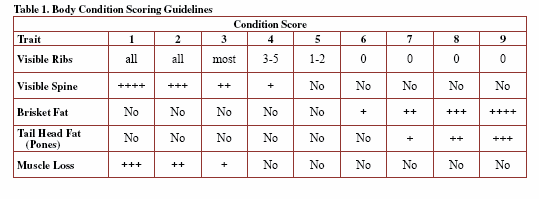



Body Condition Scoring of a Beef Herd
By Clyde Lane, Jr., Extension Beef Specialist Animal Science and published by University of Tennessee in Beef Cattle Time, Volume 24, Number 4, Fall 2006 - Body condition scoring (BCS) is a management practice all producers should perform. It provides the information needed to evaluate pasture and feeding programs. Since the BCS is linked to the productivity of the herd, it is important that animals be maintained in an acceptable body condition score.
It is not necessary to individually score each cow to come up with a body condition score for a herd.. A herd is managed as a group and changes in the feeding program are done on a herd basis. Decide on a body condition score that fits the majority of the animals. If most are in the 5 to 7 range, little nutritional adjustment is needed. Next take a look at those animals that are either too thin (BCS 1 – 4) or too fat (BCS 8 – 9). Some of these animals are too fat because they are not pregnant or failed to have a calf. They should be sent to market. If cows are too thin, a determination must be made as to cause and whether it can be corrected. Use the BCS as an indicator of the cow’s ability to wean a calf of sufficient weight and quality to make a profit.
Any animal that doesn’t fit the group should be considered for culling since it probably cannot be fed and managed individually.
November 2006


